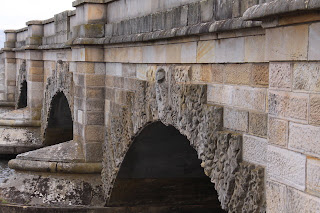



Australia is indeed blessed. Here is an immense island rimmed by thousands of miles of sandstone headlands, bays with azure waters and golden sand beaches. Living with the sea is an integral part of being an Aussie. Our last two days before returning to Canada were spent, appropriately, driving from Adelaide to Melbourne which, happily, includes the famous Great Ocean Road, probably the most beautiful coastal drive in the world.
The first day was mostly inland with some glimpses of the coast. We stayed overnight at Robe in South Australia, an attractive town with dozens of historic buildings of buff sandstone blocks and dating to the early 1800s. An obelisk (a cheap version of a lighthouse) built in 1855 stands guard on a cliff with turquoise waves pounding against the rocks below.
The second day we were immersed in the incredible beauty of the Great Ocean Road. Viewpoints were many, but the best was the Twelve Apostles (OK, perhaps only 9 and a half), large jagged stacks of rock that have been separated from the mainland by erosion. Mist swirled, waves rolled in from far out in the Southern Ocean and they stood impassively like giant sentinels.
The narrow winding road, often marked with "Drive on the left in Australia" signs led us to a broad white sand beach where we stripped down to our bathers for a final bit of sun.
Then the road turned inland and all too soon we were in Geelong and then Melbourne. Next day a giant metal box with wings carried us back to the tail-end of a Canadian winter.
The first day was mostly inland with some glimpses of the coast. We stayed overnight at Robe in South Australia, an attractive town with dozens of historic buildings of buff sandstone blocks and dating to the early 1800s. An obelisk (a cheap version of a lighthouse) built in 1855 stands guard on a cliff with turquoise waves pounding against the rocks below.
The second day we were immersed in the incredible beauty of the Great Ocean Road. Viewpoints were many, but the best was the Twelve Apostles (OK, perhaps only 9 and a half), large jagged stacks of rock that have been separated from the mainland by erosion. Mist swirled, waves rolled in from far out in the Southern Ocean and they stood impassively like giant sentinels.
The narrow winding road, often marked with "Drive on the left in Australia" signs led us to a broad white sand beach where we stripped down to our bathers for a final bit of sun.
Then the road turned inland and all too soon we were in Geelong and then Melbourne. Next day a giant metal box with wings carried us back to the tail-end of a Canadian winter.














































